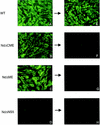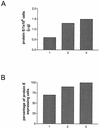Incorporation of tick-borne encephalitis virus replicons into virus-like particles by a packaging cell line
- PMID: 12885909
- PMCID: PMC167216
- DOI: 10.1128/jvi.77.16.8924-8933.2003
Incorporation of tick-borne encephalitis virus replicons into virus-like particles by a packaging cell line
Abstract
RNA replicons derived from flavivirus genomes show considerable potential as gene transfer and immunization vectors. A convenient and efficient encapsidation system is an important prerequisite for the practical application of such vectors. In this work, tick-borne encephalitis (TBE) virus replicons and an appropriate packaging cell line were constructed and characterized. A stable CHO cell line constitutively expressing the two surface proteins prM/M and E (named CHO-ME cells) was generated and shown to efficiently export mature recombinant subviral particles (RSPs). When replicon NdDeltaME lacking the prM/M and E genes was introduced into CHO-ME cells, virus-like particles (VLPs) capable of initiating a single round of infection were released, yielding titers of up to 5 x 10(7)/ml in the supernatant of these cells. Another replicon (NdDeltaCME) lacking the region encoding most of the capsid protein C in addition to proteins prM/M and E was not packaged by CHO-ME cells. As observed with other flavivirus replicons, both TBE virus replicons appeared to exert no cytopathic effect on their host cells. Sedimentation analysis revealed that the NdDeltaME-containing VLPs were physically distinct from RSPs and similar to infectious virions. VLPs could be repeatedly passaged in CHO-ME cells but maintained the property of being able to initiate only a single round of infection in other cells during these passages. CHO-ME cells can thus be used both as a source for mature TBE virus RSPs and as a safe and convenient replicon packaging cell line, providing the TBE virus surface proteins prM/M and E in trans.
Figures






References
-
- Aberle, J. H., S. W. Aberle, S. L. Allison, K. Stiasny, M. Ecker, C. W. Mandl, R. Berger, and F. X. Heinz. 1999. A DNA immunization model study with constructs expressing the tick-borne encephalitis virus envelope protein E in different physical forms. J. Immunol. 163:6756-6761. - PubMed
-
- Allison, S. L., C. W. Mandl, C. Kunz, and F. X. Heinz. 1994. Expression of cloned envelope protein genes from the flavivirus tick-borne encephalitis virus in mammalian cells and random mutagenesis by PCR. Virus Genes 8:187-198. - PubMed
-
- Blight, K. J., A. A. Kolykhalov, and C. M. Rice. 2000. Efficient initiation of HCV RNA replication in cell culture. Science 290:1972-1974. - PubMed
Publication types
MeSH terms
Substances
LinkOut - more resources
Full Text Sources
Other Literature Sources
Research Materials

